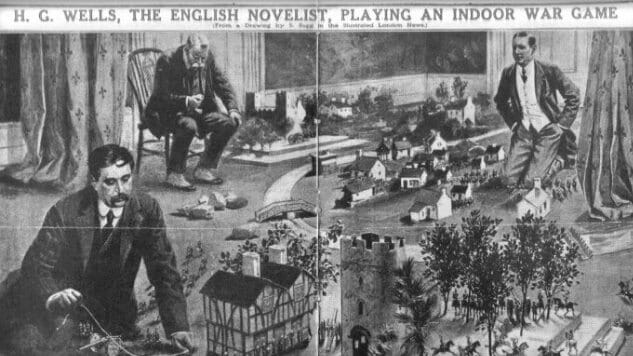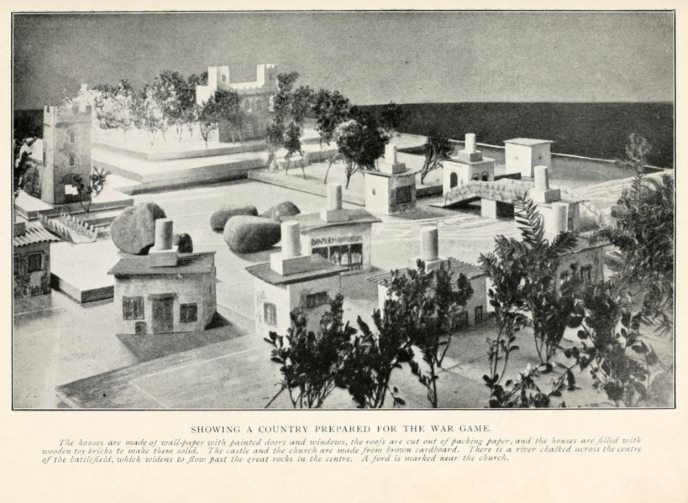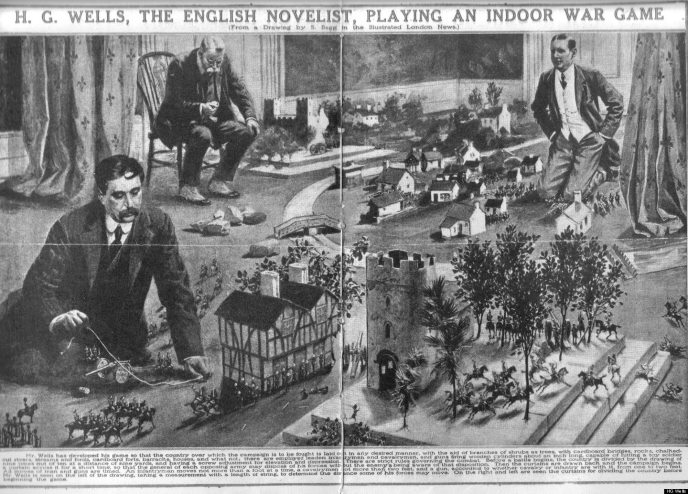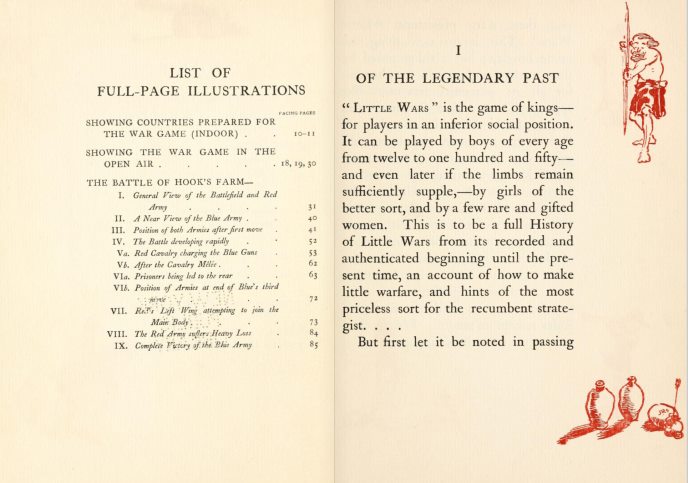
I don’t know anything about war games. War Games.
But I do like reading old things and finding connections to current things. And I like writing about them in the hope that if I can convince you that these connections can be meaningful even if (especially if) they’re not intentional or causal, then perhaps you will have a slightly more enjoyable day.
Today’s book: Little Wars; a game for boys from twelve
years of age to one hundred and fifty and for that more intelligent sort of girls who likes boys’ games and books, by H.G. Wells. Yes, that H.G. Wells—the one who wrote the novels whose readers gave us steampunk.
What a terrible subtitle for a book! A lot of the writing’s tone is very wry, as though dude can’t BELIEVE he’s getting paid to write about games (assuming that in 1913 he was, you know, getting paid).

Best known as a science-fiction novelist, Herbert George Wells did, in fact, write about games—games he himself had designed! He is sometimes cited as the “Father of Miniature Gaming” (in those days, “tabletop” games took place on the floor, because the miniatures were much less miniature than today’s miniatures).
Wells’s wife does appear in the rulebook occasionally—or at least, she took the photographs, mostly of men in suits and boaters crawling around on the ground. I can only imagine that when Wells says the game can be played “by girls of the better sort, and by a few rare and gifted women”… well, there are people far better qualified than I am to deal with that, so I’ll just leave it there and roll my eyes. But I have to wonder if Wells would have been mobilized against the “Fake Geek Girl,” or if he might think that Calvin’s “Get Rid Of Slimy girlS” sign was not entirely a joke.
I’d hoped to be able to play Wells’s game, but I lack the “spring breechloader gun,” that “altogether elegant weapon” that inspired the creation of these very thorough rules. I also lack the patience and the large amount of floor-space this game requires.

So instead I’m going to talk about the rules! I thought this would be a very Fun Approach because I could be completely free of any of the actuality of the game and just run with my own interpretations. Because I’m the writer of this piece and, well, Wells is long gone.
Unfortunately for me, Wells was a writer and so, long before you even get to anything resembling a list of rules, he walks you through the creation of those rules. He writes about what the point of the rules is—about the situations the rules are meant to allow and the situations they block.
Here’s what I gathered:
Being too much like chess is a bad thing. If your games play out like chess, why not play chess? Plus, there’s Little Wars’ use of actually-shooting toy cannons and soldiers that look like humans (no Islamic restriction on graven images to influence these designs, unlike chess pieces). The playing area, the “Country,” has shifted away from the abstract squares of chess, instead using another tradition: model village-building.
Wells details this transition, how they created spaces that he saw as less an abstraction and more a miniaturization. They were reduced in size, but not to core functional components. Topography, not topology, is what was important. This followed the cannon shot: The toy guns actually shot, so they were like miniature cannons, and so the space built around them should follow that same translation.

But the Country is not the country; the game is not the war. Wells writes about how strategy in the game is not strategy that would apply to warfare: “Now, in actual civilised warfare small detached bodies do not sell their lives dearly.” They needed to, as Wells puts it, “prevent such inhuman heroisms.” Individual soldiers attacking far superior numbers with no thought for their own nonexistent (read: not modeled-by-the-rules) lives was not believable. And so, in the pursuit of more believable realism in their simulation, they added another abstraction: points.
Points were intended as an “inducement” for the players to be less sacrificial in their dealings with their soldier pieces. Again, lead soldier pieces have no will of their own. No personal desires, sublimated to the desires of the army (the nation? The commanding officer?), that might result in self-preserving disobedience. Points gave the players something to care about beyond out-and-out winning at all costs. I don’t know much about military command, but I would think these points’ best analogue would be a commander’s desire not to have all of their soldiers die.
But notice: This is still about the commanders, the players. There is no modeling of the soldiers’ lives outside of their value to the player’s victory, values which are slightly different during (when they are extensions of the player’s will), and after (when they become symbols of the quality of that will), play.
Then the rules are laid out as individual rules, even though occasionally the need to present examples and contingencies in a list format leads to many-worded sentences difficult to parse.
But then… oh, then!
“And suddenly your author changes.
He changes into what perhaps he might have been—under different circumstances. His inky fingers become large, manly hands, his drooping scholastic back stiffens, his elbows go out, his etiolated complexion corrugates and darkens, his moustaches increase and grow and spread, and curl up horribly; a red scare, a sabre cut, grows lurid over one eye. He expands. All over he expands. He clears his throat startlingly, lugs at the still growing ends of his moustache, and says, wiht just a faint and fading doubt in his voice as to whether he can do it, ‘Yas, Sir!’”

And then General H.G.W. of the Blue Army walks we readers through his experience at the Battle of Hook’s Farm. Photos provided by “a woman war-correspondent, A.C.W., a daring ornament of her sex” (yep).
General H.G.W. relates the story in competition with HG Wells: The former snipes at the shortcomings of ”’fine writing’” (double quotes because I’m quoting the scare single-quotes from the text), while the latter provides footnotes pointing out inaccuracies in the account, which tend to, let’s say, overstate the drama of any given situation.
The last chapter, before the book spins into an appendix about kriegspiel and how boring it is and how the Little Wars franchise is… wait, no, sorry, confusing the past and the present again.
It’s Wells-the-pacifist explaining the benefits of Little Wars—how it’s more reasonable than the large-scale actual war, less wasteful and destructive. He’s being a bit of a smartass, but the entire thing takes on a heavier tone when he refers to it as Great War. In 1913, that didn’t mean trenches and No-Man’s-Lands and chemical weapons (all of which I’m sure would be both a pain AND a downer to model).

I wonder if this would be useful to game designers, at least in the way that I understand Books About Game Design. There is no overarching theory here; there are no lessons learned that promise to be true in any context. Little Wars exists precisely because of a set of physical toys and the perceptions and interests of a niche few individuals that encountered them.
Presenting the story of how the rules came to be gets in the way of thinking of the rules as a hard-and-fast list of restrictions that sprang fully-formed from Wells’s head (I wonder if Athena would be an “intelligent sort of girl who likes boys’ games and books”). It may not be personal in the way that some designers and artists try to embody their experience in their work, but it’s certainly not the easily-mass-produced list of rules and plastic/cardboard chits I was expecting from a war game.
I’d probably give it like a 9 for fun factor but a 2 for graphics, and the gameplay was a 1. (I don’t think it really took advantage of the Nook hardware.)
Brian Taylor kept singing Neutral Milk Hotel’s “Little Birds,” replacing “Birds” with “Wars.”
The photographs in Brian’s feature were filched from this marvelous scan of the book.